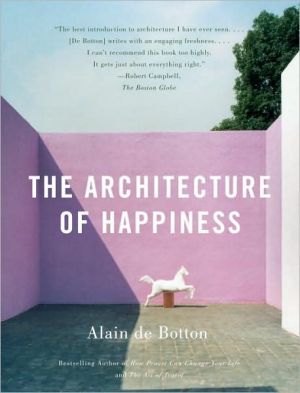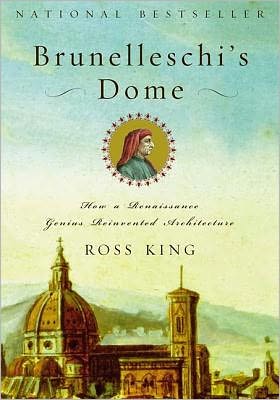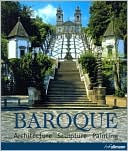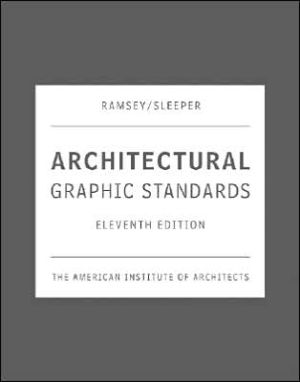The Architecture of Happiness
The Achitecture of Happiness is a dazzling and generously illustrated journey through the philosophy and psychology of architecture and the indelible connection between our identities and our locations.One of the great but often unmentioned causes of both happiness and misery is the quality of our environment: the kinds of walls, chairs, buildings, and streets that surround us. And yet a concern for architecture is too often described as frivolous, even self-indulgent. Alain de Botton starts...
Search in google:
The Achitecture of Happiness is a dazzling and generously illustrated journey through the philosophy and psychology of architecture and the indelible connection between our identities and our locations.One of the great but often unmentioned causes of both happiness and misery is the quality of our environment: the kinds of walls, chairs, buildings, and streets that surround us. And yet a concern for architecture is too often described as frivolous, even self-indulgent. Alain de Botton starts from the idea that where we are heavily influences who we can be, and argues that it is architecture's task to stand as an eloquent reminder of our full potential.The New YorkerDetermined to avoid the “two great dogmas of aesthetics”—that there is only one valid visual style, and that all styles are equally acceptable—de Botton explores how particular works of architecture succeed, by offering “more or less adequate responses to our genuine psychological needs.” Loosely adopting a set of criteria, or “virtues”—order, balance, elegance, coherence, and self-knowledge—he delineates the merits of, for instance, Herzog & de Meuron’s 1988 Stone House, in Liguria, whose exposed concrete frame saves rough, mortarless rock from “rustic incoherence.” Conversely, he excoriates the folly of Nagasaki’s massive Huis ten Bosch Dutch Village, a theme park containing a complete replica of The Hague’s royal palace. De Botton is a lively guide, and his eclectic choices of buildings and locations evince his conclusion, that “we should be as unintimidated by architectural mediocrity as we are by unjust laws.”
I. The Significance of Architecture\ 1.\ A terraced house on a tree-lined street. Earlier today, the house rang with the sound of children's cries and adult voices, but since the last occupant took off (with her satchel) a few hours ago, it has been left to sample the morning by itself. The sun has risen over the gables of the buildings opposite and now washes through the ground- floor windows, painting the interior walls a buttery yellow and warming the grainy-red brick façade. Within shafts of sunlight, platelets of dust move as if in obedience to the rhythms of a silent waltz. From the hallway, the low murmur of accelerating traffic can be detected a few blocks away. Occasionally, the letter-box opens with a rasp to admit a plaintive leaflet.\ The house gives signs of enjoying the emptiness. It is rearranging itself after the night, clearing its pipes and cracking its joints. This dignified and seasoned creature, with its coppery veins and wooden feet nestled in a bed of clay, has endured much: balls bounced against its garden flanks, doors slammed in rage, headstands attempted along its corridors, the weight and sighs of electrical equipment and the probings of inexperienced plumbers into its innards. A family of four shelters in it, joined by a colony of ants around the foundations and, in spring time, by broods of robins in the chimney stack. It also lends a shoulder to a frail (or just indolent) sweet-pea which leans against the garden wall, indulging the peripatetic courtship of a circle of bees.\ The house has grown into a knowledgeable witness. It has been party to early seductions, it has watched homework being written, it has observed swaddled babies freshly arrived from hospital, it has been surprised in the middle of the night by whispered conferences in the kitchen. It has experienced winter evenings when its windows were as cold as bags of frozen peas and midsummer dusks when its brick walls held the warmth of newly baked bread.\ It has provided not only physical but also psychological sanctuary. It has been a guardian of identity. Over the years, its owners have returned from periods away and, on looking around them, remembered who they were. The flagstones on the ground floor speak of serenity and aged grace, while the regularity of the kitchen cabinets offers a model of unintimidating order and discipline. The dining table, with its waxy tablecloth printed with large buttercups, suggests a burst of playfulness which is thrown into relief by a sterner concrete wall nearby. Along the stairs, small still-lives of eggs and lemons draw attention to the intricacy and beauty of everyday things. On a ledge beneath a window, a glass jar of cornflowers helps to resist the pull towards dejection. On the upper floor, a narrow empty room allows space for restorative thoughts to hatch, its skylight giving out onto impatient clouds migrating rapidly over cranes and chimney pots.\ Although this house may lack solutions to a great many of its occupants' ills, its rooms nevertheless give evidence of a happiness to which architecture has made its distinctive contribution.\ 2.\ Yet a concern for architecture has never been free from a degree of suspicion. Doubts have been raised about the subject's seriousness, its moral worth and its cost. A thought-provoking number of the world's most intelligent people have disdained any interest in decoration and design, equating contentment with discarnate and invisible matters instead.\ The Ancient Greek Stoic philosopher Epictetus is said to have demanded of a heart-broken friend whose house had burnt to the ground, 'If you really understand what governs the universe, how can you yearn for bits of stone and pretty rock?' (It is unclear how much longer the friendship lasted.) Legend recounts that after hearing the voice of God, the Christian hermit Alexandra sold her house, shut herself in a tomb and never looked at the outside world again, while her fellow hermit Paul of Scete slept on a blanket on the floor of a windowless mud hut and recited 300 prayers every day, suffering only when he heard of another holy man who had managed 700 and slept in a coffin.\ Such austerity has been a historical constant. In the spring of 1137 the Cistercian monk St Bernard of Clairvaux travelled all the way around Lake Geneva without noticing it was even there. Likewise, after four years in his monastery, St Bernard could not report whether the dining area had a vaulted ceiling (it does) or how many windows there were in the sanctuary of his church (three). On a visit to the Charterhouse of Dauphiné, St Bernard astonished his hosts by arriving on a magnificent white horse diametrically opposed to the ascetic values he professed, but he explained that he had borrowed the animal from a wealthy uncle and had simply failed to register its appearance on a four-day journey across France.\ 3.\ Nevertheless, such determined efforts to scorn visual experience have always been matched by equally persistent attempts to mould the material world to graceful ends. People have strained their backs carving flowers into their roof beams and their eyesight embroidering animals onto their tablecloths. They have given up weekends to hide unsightly cables behind ledges. They have thought carefully about appropriate kitchen work-surfaces. They have imagined living in unattainably expensive houses pictured in magazines and then felt sad, as one does on passing an attractive stranger in a crowded street.\ We seem divided between an urge to override our senses and numb ourselves to our settings and a contradictory impulse to acknowledge the extent to which our identities are indelibly connected to, and will shift along with, our locations. An ugly room can coagulate any loose suspicions as to the incompleteness of life, while a sun-lit one set with honey-coloured limestone tiles can lend support to whatever is most hopeful within us.\ Belief in the significance of architecture is premised on the notion that we are, for better or for worse, different people in different places - and on the conviction that it is architecture's task to render vivid to us who we might ideally be.\ 4.\ We are sometimes eager to celebrate the influence of our surroundings. In the living room of a house in the Czech Republic, we see an example of how walls, chairs and floors can combine to create an atmosphere in which the best sides of us are offered the opportunity to flourish. We accept with gratitude the power that a single room can possess.\ But sensitivity to architecture also has its more problematic aspects. If one room can alter how we feel, if our happiness can hang on the colour of the walls or the shape of a door, what will happen to us in most of the places we are forced to look at and inhabit? What will we experience in a house with prison-like windows, stained carpet tiles and plastic curtains?\ It is to prevent the possibility of permanent anguish that we can be led to shut our eyes to most of what is around us, for we are never far from damp stains and cracked ceilings, shattered cities and rusting dockyards. We can't remain sensitive indefinitely to environments which we don't have the means to alter for the good - and end up as conscious as we can afford to be. Echoing the attitude of Stoic philosophers or St Bernard around Lake Geneva, we may find ourselves arguing that, ultimately, it doesn't much matter what buildings look like, what is on the ceiling or how the wall is treated - professions of detachment that stem not so much from an insensitivity to beauty as from a desire to deflect the sadness we would face if we left ourselves open to all of beauty's many absences.\ 5.\ There is no shortage of reasons to be suspicious of the ambition to create great architecture. Buildings rarely make palpable the efforts that their construction demands. They are coyly silent about the bankruptcies, the delays, the fear and the dust that they impose. A nonchalant appearance is a frequent feature of their charm. It is only when we try our own hand at construction that we are initiated into the torments associated with persuading materials and other humans to cooperate with our designs, with ensuring that two pieces of glass will be joined in a neat line, that a lamp will hang symmetrically over the stairs, that a boiler will light up when it should or that concrete pillars will marry a roof without complaint.\ Even when we have attained our goals, our buildings have a grievous tendency to fall apart again with precipitate speed. It can be hard to walk into a freshly decorated house without feeling preemptively sad at the decay impatiently waiting to begin: how soon the walls will crack, the white cupboards will yellow and the carpets stain. The ruins of the Ancient World offer a mocking lesson for anyone waiting for builders to finish their work. How proud the householders of Pompeii must have been.\ In his essay 'On Transience' (1916) Sigmund Freud recalled a walk he took in the Dolomite Mountains with the poet Rainer Maria Rilke. It was an exquisite summer's day; the flowers were in bloom and brightly coloured butterflies danced above the meadows. The psychoanalyst was glad to be outdoors (it had been raining all week), but his companion walked with his head bowed, his eyes fixed on the ground, and remained taciturn throughout the excursion. It wasn't that Rilke was oblivious to the beauty around him; he simply could not overlook how impermanent everything was. In Freud's words, he was unable to forget 'that all this beauty was fated to extinction, that it would vanish when winter came, like all human beauty and all the beauty that men have created or may create'.\ Freud was unsympathetic; for him, the capacity to love anything attractive, however fragile it might be, was a hallmark of psychological health. But Rilke's stance, though inconvenient, helpfully emphasises how it can be those most in thrall to beauty who will be especially aware of, and saddened by, its ephemeral character. Such melancholic enthusiasts will see the moth hole beneath the curtain swatch and the ruin beneath the plan. They may at the last moment cancel an appointment with an estate agent, having realised that the house under offer, as well as the city and even civilisation itself, will soon enough be reduced to fragments of shattered brick over which cockroaches will triumphantly crawl. They may prefer to rent a room or live in a barrel out of a reluctance to contemplate the slow disintegration of the objects of their love.\ At its apex, a passion for architecture may turn us into aesthetes, eccentric figures who must watch over their houses with the vigilance of museum guards, patrolling their rooms in search of stains, a damp cloth or sponge in hand. Aesthetes will have no choice but to forgo the company of small children and, during dinner with friends, will have to ignore the conversation in order to focus on whether someone might lean back and inadvertently leave a head-shaped imprint on the wall.\ It would be pleasant to refuse in a muscular spirit to lend stray blemishes genuine significance. However, aesthetes force us to consider whether happiness may not sometimes turn on the presence or absence of a fingerprint, whether in certain situations beauty and ugliness may not lie only a few millimetres apart, whether a single mark might not wreck a wall or an errant brush stroke undo a landscape painting. We should thank these sensitive spirits for pointing us with theatrical honesty towards the possibility of a genuine antithesis between competing values: for example, an attachment to beautiful architecture and the pursuit of an exuberant and affectionate family life.\ How wise were the ancient philosophers in suggesting that we exclude from our vision of contentment anything that might one day be covered by lava or blow down in a hurricane, succumb to a chocolate smear or absorb a wine stain.\ 6.\ Architecture is perplexing, too, in how inconsistent is its capacity to generate the happiness on which its claim to our attention is founded. While an attractive building may on occasion flatter an ascending mood, there will be times when the most congenial of locations will be unable to dislodge our sadness or misanthropy.\ We can feel anxious and envious even though the floor we're standing on has been imported from a remote quarry, and finely sculpted window frames have been painted a soothing grey. Our inner metronome can be unimpressed by the efforts of workmen to create a fountain or nurture a symmetrical line of oak trees. We can fall into a petty argument which ends in threats of divorce in a building by Geoffrey Bawa or Louis Kahn. Houses can invite us to join them in a mood which we find ourselves incapable of summoning. The noblest architecture can sometimes do less for us than a siesta or an aspirin.\ Those who have made architectural beauty their life's work know only too well how futile their efforts can prove. After an exhaustive study of the buildings of Venice, in a moment of depressive lucidity, John Ruskin acknowledged that few Venetians in fact seemed elevated by their city, perhaps the most beautiful urban tapestry in the world. Alongside St Mark's Church (described by Ruskin in The Stones of Venice as 'a Book of Common Prayer, a vast illuminated missal, bound with alabaster instead of parchment, studded with porphyry pillars instead of jewels, and written within and without in letters of enamel and gold'), they sat in cafés, read the papers, sunbathed, bickered and stole from one another as, high on the church's roof, unobserved, 'the images of Christ and His angels looked down upon them.'\ Endowed with a power that is as unreliable as it often is inexpressible, architecture will always compete poorly with utilitarian demands for humanity's resources. How hard it is to make a case for the cost of tearing down and rebuilding a mean but serviceable street. How awkward to have to defend, in the face of more tangible needs, the benefits of realigning a crooked lamppost or replacing an ill-matched window frame. Beautiful architecture has none of the unambiguous advantages of a vaccine or a bowl of rice. Its construction will hence never be raised to a dominant political priority, for even if the whole of the man-made world could, through relentless effort and sacrifice, be modelled to rival St Mark's Square, even if we could spend the rest of our lives in the Villa Rotonda or the Glass House, we would still often be in a bad mood.\ 7.\ Not only do beautiful houses falter as guarantors of happiness, they can also be accused of failing to improve the characters of those who live in them.\ It seems reasonable to suppose that people will possess some of the qualities of the buildings they are drawn to: to expect that if they are alive to the charm of an ancient farmhouse with walls made of irregular chiselled stones set in light mortar.\ From the Hardcover edition.
\ From Barnes & NobleIn books like The Consolations of Philosophy, How Proust Can Change Your Life, and On Love, Alain de Botton has explored the nature of things we thought we knew. In The Architecture of Happiness, he examines the seemingly self-evident qualities of living space, beginning with a beginner's question: What is a beautiful building? As in his other books, de Botton reassesses the familiar in unexpected ways.\ \ \ \ \ William GrimesAll architecture and design is intensely personal for Mr. de Botton. Buildings have temperaments, vices and virtues. They look upon the world with an almost human face. A pillar holding up a freeway overpass can strike Mr. de Botton’s sensitive eye as a sedentary, cheerful woman, while another seems likes a punctilious, nervous accountant. The letter "f," in sleek Helvetica type, exudes optimism, while the same letter, in Poliphilus font, seems sleepy, sheepish and pensive.\ — The New York Times\ \ \ The New YorkerDetermined to avoid the “two great dogmas of aesthetics”—that there is only one valid visual style, and that all styles are equally acceptable—de Botton explores how particular works of architecture succeed, by offering “more or less adequate responses to our genuine psychological needs.” Loosely adopting a set of criteria, or “virtues”—order, balance, elegance, coherence, and self-knowledge—he delineates the merits of, for instance, Herzog & de Meuron’s 1988 Stone House, in Liguria, whose exposed concrete frame saves rough, mortarless rock from “rustic incoherence.” Conversely, he excoriates the folly of Nagasaki’s massive Huis ten Bosch Dutch Village, a theme park containing a complete replica of The Hague’s royal palace. De Botton is a lively guide, and his eclectic choices of buildings and locations evince his conclusion, that “we should be as unintimidated by architectural mediocrity as we are by unjust laws.”\ \ \ \ \ Jim HoltAs John Ruskin observed, we don't want our buildings merely to shelter us; we also want them to speak to us. But of what? De Botton has an answer. Great buildings, he says, "speak of visions of happiness"…he makes the most of this expressionist theme on his jolly (and handsomely illustrated) romp through the world of architecture. He writes eloquently of how different architectural features hint at aspects of human flourishing: how, say, pointed Gothic arches "convey ardor and intensity," whereas their rounded classical counterparts "embody serenity and poise." His visions of happiness range from the ordered complexity of the Doge's Palace in Venice to Richard Neutra's sleek modernist pavilions in the Hollywood Hills, which speak "of honesty and ease, of a lack of inhibition and a faith in the future." Wherever he casts his eye, what he sees, in material form, are the lineaments of gratified desire.\ —The New York Times Book Review\ \ \ \ \ Michael DirdaDe Botton attempts to understand aspects of that happiness by touching on the achievements or failures of particular styles and constructions. He offers us, in effect, a handsome photo album printed on coated stock, augmented by thoughtful, highly polished paragraphs and pensées. Time after time, his descriptions neatly capture the distinctiveness and character of even the most unusual buildings. Admittedly, those who prefer their sentences strictly functional may sometimes judge de Botton's a tad lyrical, just as his mini-essays risk sounding a little gushy. For the most part, though, he keeps his balance, largely through his quiet intelligence, passionate conviction and the charm of a personality lightly tinged with melancholy.\ —The Washington Post\ \ \ \ \ Publishers WeeklyWith this entertaining and stimulating book, de Botton (How Proust Can Change Your Life) examines the ways architecture speaks to us, evoking associations that, if we are alive to them, can put us in touch with our true selves and influence how we conduct our lives. Because of this, he contends, it's the architect's task to design buildings that contribute to happiness by embodying ennobling values. While he makes no claim to be able to define true beauty in architecture, he suggests some of the virtues a building should have (illustrated by pictures on almost every spread): order combined with complexity; balance between contrasting elements; elegance that appears effortless; a coherent relationship among the parts; and self-knowledge, which entails an understanding of human psychology, something that architects all too often overlook. To underscore his argument, de Botton includes many apt examples of buildings that either incorporate or ignore these qualities, discussing them in ways that make obvious their virtues or failings. The strength of his book is that it encourages us to open our eyes and really look at the buildings in which we live and work. A three-part series of the same title will air on PBS this fall. (Oct. 3) Copyright 2006 Reed Business Information.\ \ \ \ \ Library JournalDe Botton's best-selling The Art of Travel and The Consolations of Philosophy have both been converted into multipart PBS specials, and this newest book is expected to air on PBS as a three-part series in the fall. In it, de Botton explores how humans have related to architecture through the ages. He poses the philosophical question of whether or not the structure of buildings can affect human happiness. Working with the theory that we are very susceptible to our surroundings, de Botton suggests that "bad" architecture can subtly darken our moods, while other forms of architecture can bring us a sense of peace or happiness, as in the case of Europe's majestic cathedrals. De Botton guides us from the 19th century through modernism, providing insights into the meaning of style and abstract shape. Numerous excellent black-and-white photographs of all the major buildings discussed are included. While the presentation is somewhat dry, architecture and history aficionados will appreciate this comprehensive and pictorially enhanced survey. Recommended for public and academic libraries. [See Prepub Alert, LJ 6/15/06.]-Crystal Renfro, Georgia Inst. of Technology Lib. & Information Ctr., Atlanta Copyright 2006 Reed Business Information.\ \ \ \ \ Kirkus ReviewsGraceful disquisition on the significance of architecture, by a novelist and essayist whose eclectic interests range from How Proust Can Change Your Life (1997) to Status Anxiety (2004). In what may be the only contemporary volume on architecture that doesn't discuss Frank Lloyd Wright, de Botton sticks to the basics. He deals with questions of style, ideas of beauty, notions about why certain structures appeal to us. One of the most engaging chapters discusses the elements that beautiful buildings require: order, balance, elegance, coherence and self-knowledge. The author argues that we love beautiful buildings because they solidify ideas we have about ourselves and our world. They put into concrete form our aspirations; they compensate for our human weaknesses; in short, they make us happy. He believes that favored architectural styles change because of the "manifold nature of our inner needs." The author moves easily through historical periods, through fashions and fads, through architects many have heard of (Louis Sullivan) to those known principally to professionals (Michael Hopkins). He offers photographic backup for just about every point he makes and every concept he wishes to elucidate. He is adept, as well, at pointing out relationships between architecture and writing, architecture and painting. He keeps his tone personal and amiable, especially in a vivid section about a recent sojourn in Japan, where he'd hoped to see in contemporary buildings more allusions to the country's traditional and historical styles. Evident throughout is the author's fine craftsmanship. Virtually every page contains a sentence any essayist would be proud to have written. Considering the concept ofelegance, de Botton writes, "We delight in complexity to which genius has lent an appearance of simplicity." Gentle affection pervades these pages, as does knowledge of architecture that is both broad and deep. A lyrical and generously illustrated monograph about the intimate relationship between our buildings and ourselves. (To be a three-part PBS series, Fall 2006)\ \







